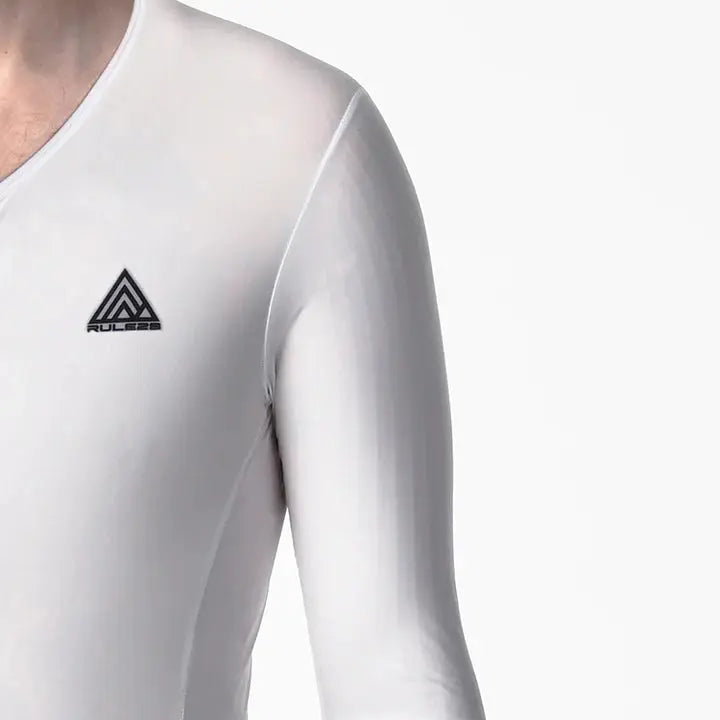Time Trial Tech has made significant advancements in the past few years as riders demand more and more from their equipment. At the World Tour and International level, the technology that goes into their skinsuits has also seen substantial progression, but until now, this has not been accessible to the public. Until now...
At Rule 28, we know that the pursuit of speed demands the very best from your kit. To bring you the fastest suit possible, with nothing held back, we’ve invested significant time and resources into the development of our latest Neo TT Suit. Here, we’ll take you behind the scenes of the rigorous wind tunnel testing process that has gone into perfecting our new skinsuit, ensuring that it delivers unparalleled aerodynamic performance.
The Importance of Aerodynamics in Cycling
At TT speeds, aero drag can account for over 90% of total resistance, and a rider's body generates the vast majority of this drag. A good amount can be done to optimize your riding position to minimize your drag, but beyond this, upgrading skinsuits is where a rider can find their greatest savings.
The less resistance you face, the faster you can go for the same amount of effort. This is where our new Neo TT Suit comes into play. Designed with cutting-edge materials and innovative techniques, our suit is engineered to provide the greatest possible advantage to its users.
Wind Tunnel Testing at Silverstone: A Closer Look
Development and testing were conducted at the Silverstone Sports Engineering Hub Wind Tunnel. Instead of using a pedaling rider, we opted for a 3D-printed mannequin of a time trialist, placed on a TT bike. This approach allowed us to gain detailed insights into how small adjustments to seam placements and fabric choices affected performance.
Understanding the Test Data
Our wind tunnel tests began at a speed of 40 kph, increasing in 5 kph increments up to 60 kph. At each speed, we measured the power in Watts required for a rider to maintain that speed. The data we collected is illuminating:
| Skinsuit | 40 kph | 45 kph | 50 kph | 55 kph | 60 kph |
|---|---|---|---|---|---|
| Neo Suit (Current w/Low Speed Base Layer) | 230.39 W | 319.1 W | 435.48 W | 579.34 W | 749.52 W |
| Neo TT Suit (Prototype w/Integrated Prototype Base Layer Sleeves) | 219.86 W | 308.97 W | 419.34 W | 554.66 W | 715.3 W |
| One TT Suit | 220.34 W | 310.21 W | 423.62 W | 562.54 W | 728.92 W |
| TT Suit 2.0 | 233.32 W | 323.64 W | 430.07 W | 562.27 W | 723.13 W |
Testing was conducted against our previous Neo Suit, which required the use of a separate Aero Base Layer, as well as our current One TT Suit (This is a single-layer sleeve design, while the Neo Suit has a double-layer sleeve). As you can see, the Neo TT Suit Prototype consistently required fewer Watts to maintain the same speeds compared to our older suit and the One TT Suit.
Real World Savings
Over a flat 10-mile TT, at 50 kph, the improved aerodynamics of the Neo Suit would save this rider approximately 15.5 seconds compared to our TT 2.0 Suit.
Put another way, as this rider crossed the line in a Neo Suit, the TT Suit 2.0 would be about 215m or 705ft behind you.
High-Speed Neo Suit
The Neo Suit is also available in a version designed for track and elite time trialists riding at average speeds of over 50 kph. Test data on this version is available here.
Why Choose the New Neo TT Suit?
Our new Neo TT Suit is an unparalleled piece of aero technology. We have spared no expense in developing this suit. It is built to help you ride faster than you ever have before. Whether you’re an elite cyclist or a serious amateur, the aerodynamic benefits of this suit will shave seconds off your time, which could be the difference between victory and a middle-of-the-pack finish.






Share:
One Skinsuit Aero Testing
Aero Sock Testing
2 comments
Cutting-edge stuff. Cool to see how the concept compares to single layers too. Is there any difference in care and durability/lifespan?
Hi
Thank you very much for publishing so detailed data.
I can’t find the link to the data of the +50kph version.
Thank you very much
Roman